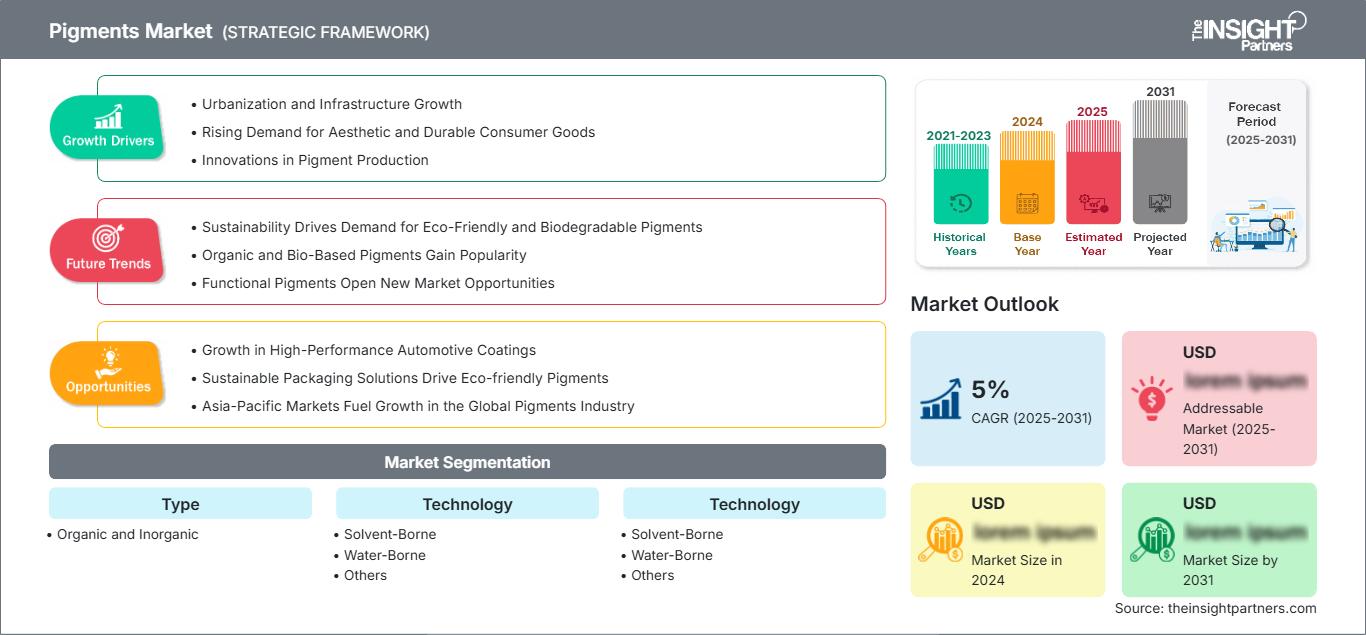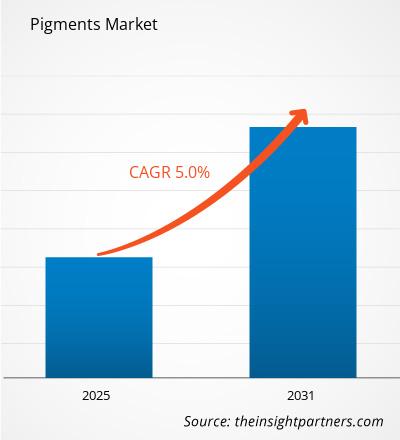Prospettiva degli analisti
Si prevede che il mercato globale dei pigmenti registrerà un CAGR del 4,2%. Il mercato dei pigmenti è destinato a crescere nel periodo previsto, trainato dalla crescente domanda da parte di settori chiave come vernici, materie plastiche e inchiostri da stampa. Questi settori fanno affidamento sui pigmenti per migliorare il colore e la durata dei loro prodotti. Il mercato è ulteriormente stimolato dalla crescente popolarità dei pigmenti organici, noti per le loro caratteristiche ecocompatibili e sostenibili. La crescita nei mercati emergenti, la domanda di pigmenti ad alte prestazioni e l'attenzione alla sostenibilità rappresentano significative opportunità di crescita per il mercato dei pigmenti. Lo sviluppo di nuove applicazioni dei pigmenti, come le celle solari e l'elettronica, sta creando nuove opportunità per il mercato. Le normative ambientali, la volatilità dei prezzi delle materie prime, la concorrenza e le innovazioni tecnologiche rappresentano sfide significative che potrebbero ostacolare la crescita del mercato dei pigmenti.
Panoramica del mercato
I pigmenti sono costituiti da particelle solide finemente macinate miscelate con olio, vernici a base d'acqua, inchiostri da stampa e materie plastiche. Altera il colore della luce riflessa o trasmessa grazie al loro assorbimento selettivo delle lunghezze d'onda. I pigmenti devono possedere proprietà specifiche per colorare efficacemente altri materiali, tra cui un elevato potere colorante rispetto ai materiali colorati e la stabilità in forma solida a una temperatura media. La crescente popolarità dei prodotti colorati su misura stimola la domanda di una gamma più ampia di pigmenti. Il crescente utilizzo di pigmenti nei cosmetici e nei prodotti per la cura della persona è un altro fattore trainante della crescita del mercato. Con l'aumento dell'urbanizzazione della popolazione mondiale, si registra una crescente domanda di alloggi e altre infrastrutture, che porta a un aumento dell'attività edilizia, che a sua volta stimola la domanda di vernici e rivestimenti, e quindi di pigmenti.
Fattori di mercato
- I pigmenti costituiscono una componente significativa di vernici e rivestimenti e la crescente domanda di questi prodotti stimola la crescita del mercato dei pigmenti. Il settore edile è un fattore trainante significativo della domanda di vernici e rivestimenti, poiché i nuovi edifici e i progetti infrastrutturali richiedono una varietà di rivestimenti per la protezione e l'estetica.
- L'industria automobilistica è un altro importante consumatore di pigmenti. I pigmenti sono utilizzati in diverse applicazioni automobilistiche, come vernici, materie plastiche e tessuti. La crescente domanda di automobili, in particolare nei paesi in via di sviluppo, sta trainando la crescita del mercato dei pigmenti.
Segmentazione del mercato
Il mercato globale dei pigmenti è segmentato in base a tipologia, tecnologia e applicazione. Il mercato globale dei pigmenti è segmentato in base alla tipologia in organici e inorganici. Il mercato dei pigmenti è segmentato in base alla tecnologia in a base solvente, a base acqua e altri. In base all'applicazione, è segmentato in vernici e rivestimenti, materie plastiche, tessuti, inchiostri da stampa, pelletteria, edilizia e costruzioni, imballaggi, trasporti e altri.
Analisi regionale
Il rapporto fornisce una panoramica dettagliata del settore, che include informazioni qualitative e quantitative. Fornisce informazioni su una panoramica e previsioni del mercato globale dei pigmenti in base a diversi segmenti. Fornisce inoltre stime sulle dimensioni del mercato e sulle previsioni dal 2021 al 2031 per cinque regioni principali: Europa, Nord America, Asia-Pacifico (APAC), Medio Oriente e Africa (MEA) e America Meridionale e Centrale. Il mercato dei pigmenti per regione è inoltre suddiviso in sottosegmenti per paesi e segmenti. Il rapporto sul mercato dei pigmenti include un'analisi e una previsione di diciotto paesi a livello globale e le tendenze e le opportunità prevalenti nella regione.
Il rapporto analizza i fattori che influenzano il mercato dei pigmenti sia dal lato della domanda che dell'offerta. Inoltre, valuta le dinamiche di mercato durante il periodo di previsione, ovvero fattori trainanti, sfide, opportunità e tendenze future. Il rapporto fornisce anche un'ampia analisi delle Cinque Forze di Porter che evidenzia i fattori che influenzano il mercato dei pigmenti in queste regioni.
Attori chiave
I rapporti coprono gli sviluppi strategici di crescita organica e inorganica essenziali nel mercato dei pigmenti. Diverse aziende si concentrano su strategie di crescita organica come lanci di prodotti, approvazioni, brevetti e altro. Le attività strategiche di crescita inorganica osservate nel mercato sono state acquisizioni, partnership e collaborazioni. Queste attività hanno aperto la strada allo sviluppo del business e della base clienti degli operatori del mercato. Si prevede che gli operatori del mercato dei pigmenti godranno di opportunità di crescita redditizie grazie alla crescente domanda di prodotti innovativi nel mercato globale. Il rapporto include profili aziendali chiave, analisi SWOT e strategie di mercato dei pigmenti. Il rapporto si concentra anche sui principali operatori del mercato, con informazioni tra cui componenti e servizi offerti, profili aziendali, dati finanziari degli ultimi tre anni e sviluppi critici negli ultimi cinque anni.
Di seguito è riportato un elenco delle aziende impegnate nel mercato globale dei pigmenti.
- AkzoNobel
- Clariant
- DIC CORPORATION
- The Chemours Company
- Venator Materials PLC
- Kronos Worldwide, Inc
- LANXESS
- ALTANA
- LB Group
- Pidilite Pigments
Personalizza questo rapporto in base alle tue esigenzePotrai personalizzare gratuitamente qualsiasi rapporto, comprese parti di questo rapporto, o analisi a livello di paese, pacchetto dati Excel, oltre a usufruire di grandi offerte e sconti per start-up e università
Mercato dei pigmenti: Approfondimenti strategici

-
Ottieni le principali tendenze chiave del mercato di questo rapporto.Questo campione GRATUITO includerà l'analisi dei dati, che vanno dalle tendenze di mercato alle stime e alle previsioni.
Approfondimenti regionali sul mercato dei pigmenti
Le tendenze regionali e i fattori che influenzano il mercato dei pigmenti durante il periodo di previsione sono stati ampiamente spiegati dagli analisti di The Insight Partners. Questa sezione illustra anche i segmenti e la geografia del mercato dei pigmenti in Nord America, Europa, Asia-Pacifico, Medio Oriente e Africa, America Meridionale e Centrale.
Ambito del rapporto sul mercato dei pigmenti
By Tecnologia- a base di solvente
- a base di acqua
- altre
- a base di solvente
- a base di acqua
- altre
- Nord America
- Europa
- Asia-Pacifico
- Sud e Centro America
- Medio Oriente e Africa
- Regno Unito
- Germania
- Francia
- Russia
- Italia
- Resto d'Europa
- Cina
- India
- Giappone
- Australia
- Resto dell'Asia-Pacifico
- Brasile
- Argentina
- Resto dell'America del Sud e Centro
- Sudafrica
- Arabia Saudita
- Emirati Arabi Uniti
- Resto del Medio Oriente e Africa
Attributo del rapporto Dettagli Dimensioni del mercato in 2024 US$ XX million Dimensioni del mercato per 2031 US$ XX Million CAGR globale (2025 - 2031) 5% Dati storici 2021-2023 Periodo di previsione 2025-2031 Segmenti coperti By Tipo - organico e inorganico
Regioni e paesi coperti Nord America - Stati Uniti
- Canada
- Messico
Leader di mercato e profili aziendali chiave - BASF SE
- Cabot Corporation
- Clariant
- DIC CORPORATION
- E. I. du Pont de Nemours and Company
- Flint Group
- Heubach GmbH
- Huntsman International LLC
- KRONOS Worldwide, Inc.
- LANXESS
Densità degli operatori del mercato dei pigmenti: comprendere il suo impatto sulle dinamiche aziendali
Il mercato dei pigmenti è in rapida crescita, trainato dalla crescente domanda da parte degli utenti finali, dovuta a fattori quali l'evoluzione delle preferenze dei consumatori, i progressi tecnologici e una maggiore consapevolezza dei benefici del prodotto. Con l'aumento della domanda, le aziende stanno ampliando la propria offerta, innovando per soddisfare le esigenze dei consumatori e sfruttando le tendenze emergenti, alimentando ulteriormente la crescita del mercato.

- Ottieni il Mercato dei pigmenti Panoramica dei principali attori chiave
- Analisi storica (2 anni), anno base, previsione (7 anni) con CAGR
- Analisi PEST e SWOT
- Valore/volume delle dimensioni del mercato - Globale, Regionale, Nazionale
- Industria e panorama competitivo
- Set di dati Excel
Report recenti
Testimonianze
Motivo dell'acquisto
- Processo decisionale informato
- Comprensione delle dinamiche di mercato
- Analisi competitiva
- Analisi dei clienti
- Previsioni di mercato
- Mitigazione del rischio
- Pianificazione strategica
- Giustificazione degli investimenti
- Identificazione dei mercati emergenti
- Miglioramento delle strategie di marketing
- Aumento dell'efficienza operativa
- Allineamento alle tendenze normative






















 Ottieni un campione gratuito per - Mercato dei pigmenti
Ottieni un campione gratuito per - Mercato dei pigmenti